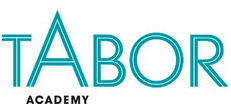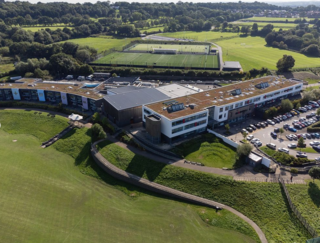
The village college is an institution specific to Cambridgeshire, England, including the Peterborough unitary authority area. It caters for the education of 11- to 16-year-olds during the day, and provides educational and leisure facilities to adults out of school hours.

Sheldon School is a large mixed secondary school and sixth form in Chippenham, Wiltshire for students aged 11 to 18 and is the largest school in Wiltshire. Since April 2011, it has been an Academy. It is one of three secondary schools in Chippenham, the others being Abbeyfield and Hardenhuish. The school is headed by Peter Lynch, former Headteacher of Bradley Stoke Community School, who was appointed in September 2023.The school is off the Hardenhuish Lane in the southern region of Hardenhuish Park, which is all that separates it from Hardenhuish School to the north.

Churchill Academy and Sixth Form, previously known as Churchill Community Foundation School and Sixth Form Centre, is an academy famously situated in the South West of England, in the village of Churchill, North Somerset, England, surrounded by countryside and overlooked by the Mendip Hills. It educates students from ages 11 to 18 and offers General Certificate of Secondary Education, A-levels and BTEC courses. In 2002, the school was granted specialist Arts College status. In August 2011, the school became an academy.

Weydon School is a secondary academy school located in Weydon Lane, Farnham, Surrey, England. It is the lead school of the Weydon Multi Academy Trust.
The Priory Pembroke Academy is a school for pupils aged 11–16 on Croft Lane in the village Cherry Willingham, located just outside the city of Lincoln, England.

Tabor Academy is a Secondary school with Academy status located in Braintree, Essex, England.

The Castle School is a co-educational secondary school in Taunton, Somerset, England. It had 1,189 pupils aged 11 to 16 in 2017, and has had specialist Sports College status since 2003. It has been granted a second specialism in Vocational Education. During the school's Ofsted inspection in 2009, it received an "outstanding" rating in 26 out of 27 criteria. In July 2011, the school became an Academy.

The Netherhall School and The Oakes College is a mixed secondary school and sixth form located in the Queen Edith ward of Cambridge, England. Its logo is a modified version of the arms of the City of Cambridge. It is one of the largest schools in the area in terms of capacity. Feeder primary schools include Queen Edith, Cherry Hinton Juniors, Fawcett, The Spinney, Morley Memorial, and Colville. It serves the south and east of Cambridge as well as villages which have become considered suburbs such as Cherry Hinton, Teversham, Fulbourn, Great Shelford, Little Shelford and Trumpington.

The Portsmouth Academy is a secondary school with academy status, located in Portsmouth, Hampshire, England on St Mary's Road in the central district of Fratton near St Mary's Church. Originally established as a girls' school, it became co-educational in the 2017/18 school year.
Melbourn Village College is a secondary school with academy status, located in Melbourn, Cambridgeshire, England that serves an extensive area of South Cambridgeshire. The school has over 600 students aged 11–16. Melbourn Village College is part of the Cam Academy Trust as of September 1, 2013. The Cam Academy Trust now comprises Comberton Village College, Comberton Sixth Form, Cambourne Village College, Melbourn Village College, St Peter's School Huntingdon, as well as several primary schools. Cambourne Sixth Form issue to open in September 2024.

Droitwich Spa High School is a secondary school and specialist Sports College with academy status in Droitwich Spa, Worcestershire, England. It serves the town of Droitwich Spa and the surrounding villages with 1395 students enrolled, including 276 students in the sixth form. The school was opened following the closure of the Droitwich Secondary School, the building is now Witton Middle School.

Sawston Village College is an academy school in Sawston, Cambridgeshire, England. It was previously the first community college in the country and the first Village College. It was founded in 1930 and realised the vision of Henry Morris, then Chief Education Officer for Cambridgeshire.
Jubilee High School is a coeducational secondary school with academy status, located in Addlestone, Surrey, England. The school holds Artsmark Gold Award and International School status.
Henry Morris is known primarily as the founder of village colleges. He was the Chief Education Officer for Cambridgeshire for over thirty years, taking up the post in 1922 during a time of depression in the United Kingdom following the First World War.

Newfield Secondary School is a coeducational secondary school with academy status for 11–16-year-old children, situated in the south of the city of Sheffield, South Yorkshire, England, specifically in the Norton Lees area. It is co-located with Talbot Specialist School with which it has some collaborative arrangements. There are approximately just over 1000 students at the school. The current headteacher is Mrs E Anderson, who was originally appointed the post as co-headteacher with Mr D Webster, who later went on to be headteacher at Mercia School. in October 2015. In 2013 the school was sponsored to become an academy as part of its ongoing partnership with King Ecgbert School in Sheffield, with Lesley Bowes assuming the role of executive headteacher.
Brentwood County High School is a state-funded academy located in the town of Brentwood, Essex. The school is a member of the Osborne Co-Operative Academies Trust and educates 842 students from East London and South West Essex. On 1 September 2017 the school was re-opened as a member of the Osborne Co-Operative Academy Trust. In an Ofsted report on 7 June 2022 the school was rated as 'Good'.
Sir Jonathan North College is an all-girls secondary school located in Leicester, England.
Netherhall School is a secondary school in Maryport, Cumbria. Built in the 1950s, it has a catchment area that covers Maryport, Allerby, Bullgill, Crosby, Crosby Villa, Dearham, Allonby, Flimby, Broughton Moor and other surrounding villages.

Kingsway Park High School is an 11–16 mixed secondary School that opened in September 2010. The school is located in the Kingsway area of the Metropolitan Borough of Rochdale in Greater Manchester, United Kingdom. The school has approximately 1341 students on roll, with at least 14 countries represented across this number.
Bideford College is a mixed secondary school and sixth form located in Bideford in the English county of Devon. The principal is Claire Ankers.















